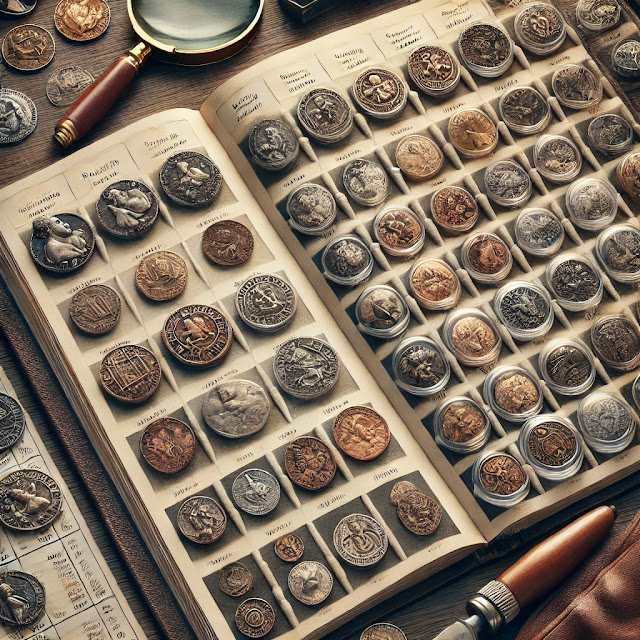The Numismatist's Guide to Coin Catalogs: Navigating the Treasury of Numismatic Knowledge
Introduction
In the world of coin collecting, the coin catalog is an indispensable tool, akin to a treasure map that leads collectors to the riches of numismatic knowledge. Experienced collectors understand that these catalogs are more than just reference books; they are windows into the history, culture, and artistry of coins. In this article, we embark on a journey through the captivating realm of coin catalogs, exploring their significance, types, contents, and the invaluable role they play in the lives of seasoned numismatists.
This image showcases a well-organized collection of various coins from different historical periods, especially medieval coins, displayed neatly in a catalog with descriptive labels and information. The background includes a magnifying glass, gloves, and other coin-collecting tools, set on a polished wooden table, creating a sophisticated and scholarly atmosphere.
The Significance of Coin Catalogs
Coin catalogs serve as the foundation of a collector's journey. Their importance lies in their ability to:
1. Educate: Catalogs provide comprehensive information about coins, offering insights into their history, design, and cultural context. They are essential educational resources for experienced collectors.
2. Identify: Catalogs assist in the identification of coins, helping collectors determine their origin, date, denomination, and other important details.
3. Value: Catalogs often include price guides or valuations, aiding collectors in assessing the approximate value of their coins in the market.
4. Organize: Catalogs help collectors organize their collections by providing a structured framework for categorizing coins.
5. Record Keeping: They serve as valuable tools for recording a collector's inventory and documenting the provenance of coins.
Types of Coin Catalogs
Experienced collectors are well-acquainted with various types of coin catalogs, each catering to different aspects of numismatics:
1. Country-Specific Catalogs: These catalogs focus on the coins of a specific country or region, providing detailed information about their coinage history.
2. Periodical Catalogs: Published periodically, these catalogs are updated to reflect changes in the numismatic market and new discoveries.
3. Ancient Coin Catalogs: Specialized catalogs focus on ancient coins, offering detailed descriptions and historical context for coins from antiquity.
4. Auction Catalogs: These catalogs accompany numismatic auctions and feature high-quality images and descriptions of the coins up for bid.
5. Online Catalogs: In the digital age, online catalogs have become increasingly popular, offering easily accessible databases of coin information.
Contents of Coin Catalogs
Experienced collectors find a wealth of information within the pages of coin catalogs:
1. Coin Descriptions: Detailed descriptions of coins, including inscriptions, designs, and dimensions, help collectors identify their specimens.
2. Historical Context: Catalogs often include historical narratives, providing insight into the political, cultural, and economic context in which coins were minted.
3. Images: High-quality images of coins are essential for visual identification and appreciation of their artistic and historical features.
4. Mintage Data: Information about the coin's mintage, including mint marks, minting techniques, and variations, is crucial for collectors.
5. Valuations: Some catalogs include price guides or estimated values for coins in various conditions, helping collectors gauge their collection's worth.
The Role of Coin Catalogs in Research
Experienced collectors often turn to catalogs for numismatic research:
1. Attribution: Catalogs aid in attributing a coin to its specific type, variety, and historical context, an essential aspect of advanced numismatic study.
2. Comparative Analysis: Collectors use catalogs to compare their coins with similar specimens, deepening their understanding of variations and historical significance.
3. Market Trends: Catalogs help collectors track market trends, prices, and demand for specific coins or series.
4. Historical Research: Catalogs are valuable resources for historians, providing insights into the economic and political history of different regions and eras.
Conclusion
Coin catalogs are not just reference books; they are keys to the treasury of numismatic knowledge. For experienced collectors, these catalogs are trusted companions on their numismatic journeys, guiding them through the vast and intricate world of coins.
As you continue your exploration of the captivating world of coin collecting, may your coin catalogs be the compasses that lead you to new discoveries, deeper understanding, and an ever-greater appreciation of the rich tapestry of history and culture woven into each numismatic artifact. Happy collecting, and may your coins forever hold stories waiting to be shared.




No comments:
Post a Comment